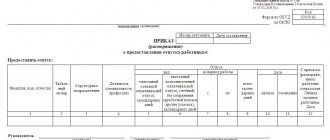Features of the rotation method
The Labor Code of the Russian Federation defines the shift method of work as a special algorithm for organizing work outside the employee’s place of residence.
The specifics are described in Chapter 47 and Article 297. It is also discussed in the Decree of the USSR State Labor Committee of December 31, 1987 No. 794/33-82, but only in that part that does not contradict the norms of labor legislation. Shift work is often used in the oil and gas industry, railway transport, and construction. An important feature of the method is that it is not a business trip. It has a time limit of 1 month. In special cases, this period is extended by management to 3 months, but the opinion of the trade union (if there is one) must be taken into account.
Work on a rotational basis according to the Labor Code of the Russian Federation is justified by a number of reasons, for example:
- lack of financial feasibility to return employees to their place of residence every day;
- remoteness of the place of work;
- the need to reduce the duration of construction procedures.
Employees in this format live:
- in settlements created by the enterprise;
- in residential premises paid for by the organization.
How to introduce it at the enterprise
The Labor Code of the Russian Federation in Chapter 47 explains the algorithm for introducing exhaust at an enterprise. To do this, a number of steps are taken:
Step 1. Make a decision. This is done by the management of the organization based on:
- technical and economic calculations;
- calculating the effectiveness of the algorithm.
Step 2. Reflect the calculations in special design and technological documents. They are the basis for forming a conclusion about the advisability of using the rotation method.
Step 3. Develop an administrative document for the enterprise. It needs to reflect:
- the date of introduction of the new system in the organization;
- algorithm for settlements with employees taking into account the use of accumulated labor time;
- terms of payment, duration;
- schedule as an appendix to the document.
Step 4. Agree on the method and order with the trade union:
- by sending the project to the trade union;
- having received a motivated written review no later than 5 working days.
Step 5. Approve the agreed order. It is imperative that all employees affected by the new work schedule be familiarized with it.
A fragment of the work schedule for a rotation worker for December 2021 is given below:
| 4 | 5 | 6 | 7 | 8 | 9 | 10 | 11 | 12 | 13 | 14 | 15 | 16 | 17 | 18 | 19 | 20 | 21 | 22 | 23 | 24 | 25 | 26 | 27 | 28 | 29 | 30 | 31 |
| Sun | Mon | Tue | Wed | Thu | Fri | Sat | Sun | Mon | Tue | Wed | Thu | Fri | Sat | Sun | Mon | Tue | Wed | Thu | Fri | Sat | Sun | Mon | Tue | Wed | Thu | Fri | Sat |
| D | 10 | 10 | 10 | 10 | 10 | 10 | Vv | 10 | 10 | 10 | 10 | 10 | 10 | Vv | 10 | 10 | 10 | 10 | 10 | 10 | Vv | M | M | M | M | M | IN |
Work and rest schedule
The shift consists of a period during which work is carried out at the site, and rest time between such periods (Part 1 of Article 299 of the Labor Code of the Russian Federation).
The duration is no more than 1 month, in exceptional cases - up to 3 months (Part 2 of Article 299 of the Labor Code of the Russian Federation). But the decision to extend the period must be accompanied by the consent of the trade union.
The time for work and rest is established by the schedule (Part 1 of Article 301 of the Labor Code of the Russian Federation). The document is approved taking into account the opinion of the trade union. Employees must be familiarized with it at least 2 months in advance.
The chart reflects the dates:
- beginnings and endings;
- travel time to and from the workplace;
- time to rest.
The period of travel is excluded from the period of working time. It refers to inter-shift rest (part 2 of article 300, part 1,2 of article 301 of the Labor Code of the Russian Federation, paragraph 1,2 of clause 4.2 of the Regulations approved by the Decree of the State Committee of Labor of the USSR dated December 31, 1987 No. 794/33-82) .
Work or shift during each day is no more than 12 hours (Article 94 of the Labor Code of the Russian Federation, paragraph 3, clause 4.2 of the Resolution of the USSR State Committee for Labor of December 31, 1987 No. 794/33-82)
In some cases, overtime work is possible (according to the rules of Article 99 of the Labor Code of the Russian Federation). Overtime may accumulate in hours during a shift schedule, and these hours are not a multiple of the entire work day. Subsequently, they are summed up to a whole day of work. The employee receives them in the form of additional rest (Part 4 of Article 301 of the Labor Code of the Russian Federation).
Shift: what kind of schedule is this, what does it mean - working conditions
This type of employment is beneficial not only to workers, but also to the enterprise. But it's important to understand that for people it involves daily, often strenuous physical activity for a certain number of days in a row. Sometimes this is a deterioration in the usual lifestyle and distance from home and family. Not everyone can do this, which is why most companies limit their hiring to men. But these are not the only restrictions. Let's look at this issue in more detail.
Who has the right to work
There are two important factors according to which applicants are selected for each position - profession and physical health. Often the shift is located in places remote from the city and populated areas. Therefore, a person with chronic diseases should not go to the Far North.
Determines whether you can go to work, doctor. He also issues the appropriate certificate for the employer. Which doctors will have to be visited regularly between shifts is determined by the enterprise and the direction of its activities. This is enshrined in local acts.
Restrictions
There are several categories of people for whom this type of activity is unacceptable:
- pregnant and lactating women;
- guardians or parents of at least three children - one of the adults must remain with the wards;
- persons under 18 years of age;
- those who have not undergone a medical examination for any reason.
How is it paid?
Payment for work on a rotational basis (Labor Code of the Russian Federation, Chapter 47) is carried out taking into account a number of features. For example, Article 302 of the Labor Code of the Russian Federation determines the possibility of obtaining certain preferences during shift shifts. It can be:
- shift allowances;
- free housing;
- payment for travel days to and from the facility, as well as travel delays.
During the shift period, it is necessary to establish a summarized accounting of labor time (Article 300 of the Labor Code of the Russian Federation). As a rule, a time-based payment system is used: tariff rates or official salaries (Parts 2.3 of Article 129 of the Labor Code of the Russian Federation). But a piecework system can be used.
Salaries are calculated taking into account bonuses and shift allowances. Rest days paid between shifts are included in the remuneration.
IMPORTANT!
Time for rest, travel, travel delays are calculated without taking into account regional coefficients and compensation for special working conditions.
As an incentive, the manager has the right to establish incentive bonuses, which represent part of the salary (Part 1 of Article 129 of the Labor Code of the Russian Federation). The employer determines the terms of payments himself (parts 1, 2 of Article 135 of the Labor Code of the Russian Federation). The bonus is accrued to the employee's salary without taking into account payment for days that fall on rest between shifts.
Shift bonus is another compensation payment for specific working conditions. Payment is made for each actual day, as well as travel time there and back.
Holiday rules
The Labor Code regulates vacation in the usual manner only after the days of rest between shifts have been used. The employee is guaranteed to receive 28 calendar days - the main rest. Additional days are provided for work:
- in the Far North - 24 calendar days;
- in territories equated to the Far North - 16 calendar days;
- in the south of Eastern Siberia and the Far East - 8 calendar days.
The length of service, which allows for additional rest, includes both days of shift and actual days on the road, determined by the schedule.
EXAMPLE No. 1
A drilling rig operator works on a 4-week, 10-hour shift. In this case, the employee gets 6 working days and one day off per week.
However, the day off does not necessarily have to be Saturday or Sunday. The employment contract with the employee may specify another day, for example, Tuesday.
Before moving on to the rules for drawing up a work schedule, it is necessary to understand the features of the summarized working time during shift work, as well as the regime and rest of the shift worker.
How to register employees according to the Labor Code of the Russian Federation
To hire an employee on a rotational basis, you need to:
Step 1. Provide a medical examination at the employer’s expense.
Step 2. Conclude an employment contract, indicating in it:
- place of work with the address of the facilities where the shift is taking place;
- the fact of hiring an employee on shift;
- working hours;
- the duration of additional leave if the activity is carried out in the Far North and equivalent zones.
Step 3. Issue an order for acceptance, indicating in it that the work will be on a rotational basis, and the place where the shift workers will gather.
Step 4. When filling out a work book, indicate that your work activity is organized on a rotational basis.
Documents for registration
When making the transition to a rotational work method, you need to observe some nuances. It must be taken into account that not everyone is allowed to do this type of work .
Categories of persons with whom a rotation contract is not concluded (Article 298):
- minors;
- pregnant women;
- women with children under 3 years of age;
- a man, if he is the child’s sole caregiver;
- persons who, for some medical reason, are not allowed to work in unfavorable climatic conditions.
When going on shift, the manager must prepare a number of documents:
- conclude an agreement with an employee (if the worker works permanently at the enterprise, then an additional agreement to the employment contract for a shift is concluded with him, and if the employee is invited from the outside, then only an employment contract is sufficient);
- issue an order to switch to shift work;
- obtain written consent of the trade union for this activity;
- approve the shift worker's work schedule.
Watch a detailed video about the design of a shift work method:
Employment contract
Peculiarities of labor regulation for persons working on a rotational basis are prescribed in the employment contract .
It should contain the following items:
- A cap . This is the standard part. It indicates the name of the enterprise, its address, the time of drawing up the contract, and the employee’s passport details.
- General terms . In this paragraph, it is necessary to indicate that the work involves a rotation method. The exact location of the work object is noted. The duration of the work is prescribed.
- Conditions of material remuneration for work. The tariff rate and possible surcharges are indicated. It is necessary to indicate how the payment will be formed (fixed salary, piece rate or time-based scheme).
- Duration of the working period and rest period. The contract specifies the actual working hours. This indicator includes not only the duration of the labor process itself, but also the time it takes to arrive from the gathering place to the immediate work point. It must be remembered that, by law, one work shift cannot be longer than 12 hours. This paragraph also specifies the conditions for granting various vacations and the nuances of receiving payment for overtime work.
- Compensation and guarantee. This is a standard clause in the contract. It stipulates: compulsory medical insurance, mutual responsibility of the employee and the employer, conditions and terms of termination of the contract.
- Conclusion. The agreement is signed by both parties and confirmed by a seal.
You can read more about the essential terms of the employment contract here.
Work schedule for a shift worker
The greatest number of problems arise when drawing up a work schedule. To avoid conflicts, you need to resolve this issue in advance.
The shift provides for the work schedule established by the Labor Code. It is characterized by a 40-hour work week (typical work is 5 days a week for 8 hours). All time that an employee additionally spends on work is considered overtime. Days of overtime are paid additionally (more details in the section on inter-shift rest).
Overtime shift work in which employees are involved must be paid according to an additional scheme. The first 2 hours of overtime require payment 1.5 times higher than the standard one. If the processing lasts more than 2 hours, then the additional payment is 2 times higher.
To record working hours directly on the shift itself, use a time sheet, or an individual card for each employee . In the report card, using numbers and letters that form a code, a strict calculation of the time the employee is on shift is kept.
| Letter code | Numeric code | What time is taken into account? |
| OB | 27 | Inter-shift rest |
| VM | 05 | Actual daily working hours |
| IN | 26 | Allotted days off on duty |
To indicate the time spent traveling from the place of temporary residence to the immediate work site, sometimes the code “P” is used in the timesheet. It was approved and enshrined in Resolution of the State Statistics Committee of the Russian Federation No. 20 of March 24, 1999.
Sample schedule for workers on a rotational basis (clickable):
Order to switch to shift work
The system for introducing rotational work at an enterprise is established by the employer. But to implement a shift, several rules must be followed:
- The normative act , together with the corresponding justification for the need for a shift, is submitted to the enterprise trade union for consideration.
- Within five days, the trade union organization makes a decision on the proposal received. The union can either support or reject the initiative.
- The employer can approve the transfer order without taking into account the opinion of the workers' organization. In this case, the union’s disagreements must be noted in the protocol. If there is no trade union at the enterprise, the manager independently approves the order, relying on Art. 74. The approved order must contain: the name and exact address of the work site, indication of the full name and positions of the persons transferred to the shift, a note on the consent of these persons to work in a similar way.
- Inform employees in writing 2 weeks before the upcoming transfer about the change in work form.
Sample order on the introduction of a rotational work method:
Sometimes workers, for one reason or another, refuse to be transferred to rotational work. In this case, the employer is obliged to offer an alternative vacancy. If there are no vacancies, or if the employee is not satisfied with the offers, then the employment contract should be terminated.
The assignment of an employee to a shift may look like this:









